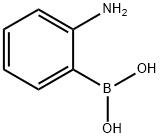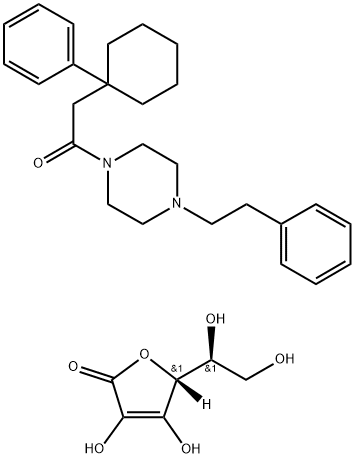2-Aminophenylboronic acid
- CAS NO.:5570-18-3
- Empirical Formula: C6H8BNO2
- Molecular Weight: 136.94
- MDL number: MFCD01074645
- SAFETY DATA SHEET (SDS)
- Update Date: 2023-04-23 13:52:06

What is 2-Aminophenylboronic acid?
Chemical properties
Crystalline powder
The Uses of 2-Aminophenylboronic acid
2-Aminophenylboronic acid is used in the preparation of affinity sites for antibacterial drugs like ampicillin. A useful synthesis intermediate.
The Uses of 2-Aminophenylboronic acid
2-Aminobenzeneboronic acid derivative is used in the synthesis of quinolines by reacting with alpha, beta unsaturated ketones. Its hydrochloride derivative is used in the preparation of designed boronate ligands for glucose-selective holographic sensors.
Properties of 2-Aminophenylboronic acid
| Melting point: | 188-190°C |
| Boiling point: | 346.9±44.0 °C(Predicted) |
| Density | 1.23±0.1 g/cm3(Predicted) |
| storage temp. | under inert gas (nitrogen or Argon) at 2–8 °C |
| pka | 8.83±0.53(Predicted) |
| color | light yellow |
| BRN | 2962939 |
| CAS DataBase Reference | 5570-18-3(CAS DataBase Reference) |
Safety information for 2-Aminophenylboronic acid
| Signal word | Warning |
| Pictogram(s) |
 Exclamation Mark Irritant GHS07 |
| GHS Hazard Statements |
H315:Skin corrosion/irritation H319:Serious eye damage/eye irritation H335:Specific target organ toxicity, single exposure;Respiratory tract irritation |
| Precautionary Statement Codes |
P261:Avoid breathing dust/fume/gas/mist/vapours/spray. P304+P340:IF INHALED: Remove victim to fresh air and Keep at rest in a position comfortable for breathing. P305+P351+P338:IF IN EYES: Rinse cautiously with water for several minutes. Remove contact lenses, if present and easy to do. Continuerinsing. P405:Store locked up. |
Computed Descriptors for 2-Aminophenylboronic acid
2-Aminophenylboronic acid manufacturer
Sri Neelima Laboratories
1Y
Phone:+91-9849736989
Whatsapp: +91 9849736989
product: 5570-18-3 2-Aminophenylboronic acid 99%
CNS Labs Private Limited
1Y
Phone:+undefined91-8284987467
Whatsapp: +91- 8284987467
product: 5570-18-3 98%
New Products
(S)-3-Aminobutanenitrile hydrochloride 4-Methylphenylacetic acid N-Boc-D-alaninol N-BOC-D/L-ALANINOL Tert-butyl bis(2-chloroethyl)carbamate 3-Morpholino-1-(4-nitrophenyl)-5,6-dihydropyridin- 2(1H)-one Furan-2,5-Dicarboxylic Acid Tropic acid 1-Bromo-3,5-Di-Tert-Butylbenzene S-2-CHLORO PROPIONIC ACID ETHYL ISOCYANOACETATE 2-Bromo-1,3-Bis(Dimethylamino)Trimethinium Hexafluorophosphate 4-IODO BENZOIC ACID 3-NITRO-2-METHYL ANILINE 1-(2,4-DICHLOROPHENYL) ETHANAMINE (2-Hydroxyphenyl)acetonitrile 4-Bromopyrazole 2-(Cyanocyclohexyl)acetic acid 4-methoxy-3,5-dinitropyridine 1-(4-(aminomethyl)benzyl)urea hydrochloride 2-aminopropyl benzoate hydrochloride diethyl 2-(2-((tertbutoxycarbonyl)amino) ethyl)malonate tert-butyl 4- (ureidomethyl)benzylcarbamate Ethyl-2-chloro((4-methoxyphenyl)hydrazono)acetateRelated products of tetrahydrofuran








You may like
-
 5570-18-3 2-Aminophenylboronic acid 99%View Details
5570-18-3 2-Aminophenylboronic acid 99%View Details
5570-18-3 -
 5570-18-3 98%View Details
5570-18-3 98%View Details
5570-18-3 -
 2-Aminobenzeneboronic acid CAS 5570-18-3View Details
2-Aminobenzeneboronic acid CAS 5570-18-3View Details
5570-18-3 -
 1975-50-4 98%View Details
1975-50-4 98%View Details
1975-50-4 -
 2-HYDROXY BENZYL ALCOHOL 98%View Details
2-HYDROXY BENZYL ALCOHOL 98%View Details
90-01-7 -
 2-Chloro-1,3-Bis(Dimethylamino)Trimethinium Hexafluorophosphate 221615-75-4 98%View Details
2-Chloro-1,3-Bis(Dimethylamino)Trimethinium Hexafluorophosphate 221615-75-4 98%View Details
221615-75-4 -
 14714-50-2 (2-Hydroxyphenyl)acetonitrile 98+View Details
14714-50-2 (2-Hydroxyphenyl)acetonitrile 98+View Details
14714-50-2 -
 118753-70-1 98+View Details
118753-70-1 98+View Details
118753-70-1
Statement: All products displayed on this website are only used for non medical purposes such as industrial applications or scientific research, and cannot be used for clinical diagnosis or treatment of humans or animals. They are not medicinal or edible.